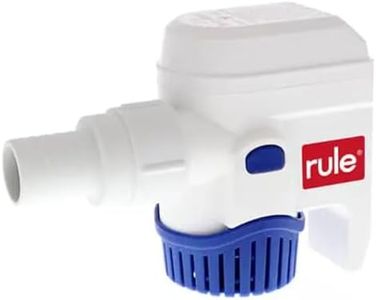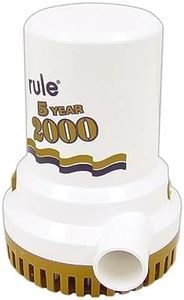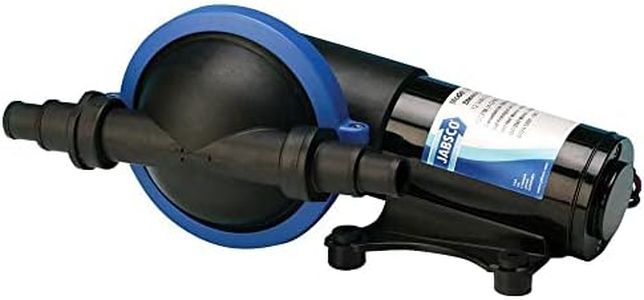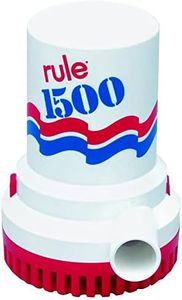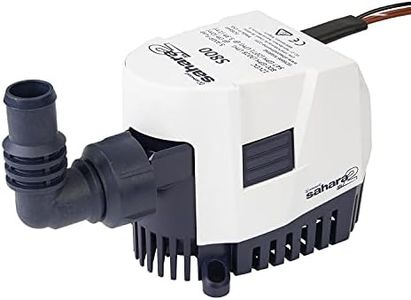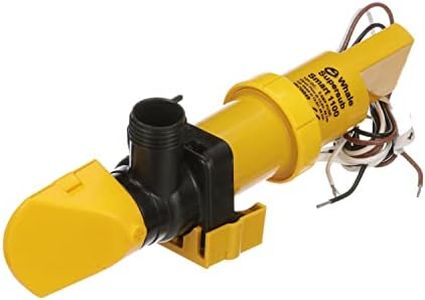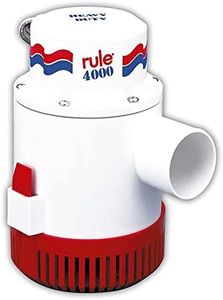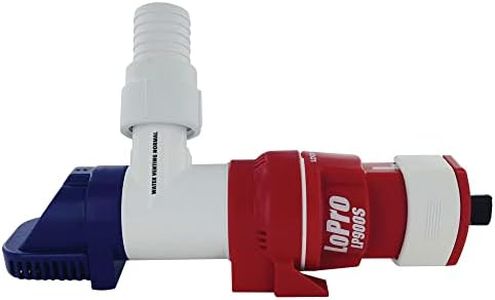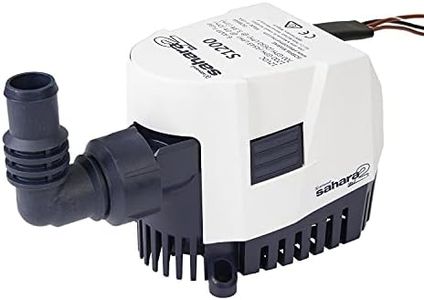We Use CookiesWe use cookies to enhance the security, performance,
functionality and for analytical and promotional activities. By continuing to browse this site you
are agreeing to our privacy policy
10 Best Bilge Pumps
From leading brands and best sellers available on the web.By clicking on a link to a third party's website, log data is shared with that third party.
Buying Guide for the Best Bilge Pumps
Selecting the right bilge pump is crucial for maintaining the safety and dryness of your boat. Bilge pumps remove unwanted water that accumulates in the bilge (the lowest compartment inside your boat’s hull). Choosing the right pump involves understanding your specific boating environment, the size of your vessel, and the amount of water you might need to move quickly in an emergency. To make a smart purchase, focus on a few essential specifications that determine performance, reliability, and suitability for your needs.Pump Capacity (GPH/LPH)Pump capacity is usually measured in gallons per hour (GPH) or liters per hour (LPH). This figure tells you how much water the pump can move in an hour under ideal conditions. The bigger your boat, or the more vulnerable you are to heavy water entry (from rain, waves, or leaks), the higher the capacity you’ll need. Smaller pumps (around 500-750 GPH) are ideal for small boats, kayaks, or dinghies with modest needs. Mid-range pumps (1000-2000 GPH) suit medium-sized vessels or those who spend more time on the water. High-capacity pumps (over 2000 GPH) are for larger boats or high-risk situations. Think about the size of your bilge area and the likelihood of serious flooding—pick capacity based on the worst case you might face.
Pump Type (Manual vs Automatic)There are two main types: manual and automatic. Manual pumps require you to switch them on, while automatic pumps have a built-in float switch or sensor to detect water and turn on by themselves. Manual pumps can save battery life as they only work when you decide, but automatic pumps add convenience and safety, especially if you’re away from the boat or if water comes in unexpectedly. For most users, especially those who leave their boats unattended, an automatic pump provides better peace of mind. If you’re on a small boat that’s always attended, a manual pump might be enough.
VoltageMost bilge pumps are designed for either 12V or 24V electrical systems, in line with most marine batteries. A 12V pump is standard for small and medium boats, while larger boats with more powerful electrical systems might use 24V. Always match the pump’s voltage to your boat’s battery system to ensure safe and reliable operation. Using the wrong voltage can damage the pump or cause it to run poorly.
Pump MaterialBilge pumps are made with different materials, often plastic, stainless steel, or marine-grade composites. Material quality affects durability, especially in saltwater environments where corrosion is a big issue. For saltwater and frequent use, look for corrosion-resistant materials like stainless steel shafts and high-grade plastics to ensure a long-lasting pump. If you boat mainly in freshwater or use it only occasionally, standard marine plastics are usually sufficient.
Discharge Size (Hose Diameter)The discharge size is the diameter of the hose that can be attached to the pump’s outlet. Common sizes are 3/4 inch, 1 inch, and 1-1/8 inch. A larger hose diameter allows more water to be expelled faster, reducing the time water stays in your boat. Make sure the discharge size matches your existing hose or fittings, or be prepared to buy matching hoses. For high-capacity pumps, larger diameters are beneficial, while for smaller boats, standard sizes work fine.
Installation TypeBilge pumps can be submersible (mounted in the bilge and operate underwater) or non-submersible (installed above the water and use a hose to draw water out). Submersible pumps are simple, compact, and easier to install in tight spaces. Non-submersible pumps are generally used for larger installations or where the bilge is difficult to access. Consider your available space and ease of access when choosing the installation type; most small to mid-size recreational boats use submersible pumps.
Ease of MaintenanceEase of maintenance includes how simple it is to clean the pump, check for clogs, or replace any parts. Pumps with snap-off strainers or tool-free casings are easier to maintain, reducing downtime and hassle. If you frequently boat in areas with debris or dirt in the water, pick a pump that is easy to take apart and clean, ensuring it remains reliable and efficient.
